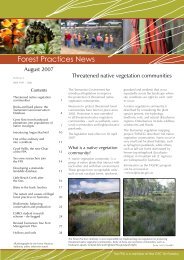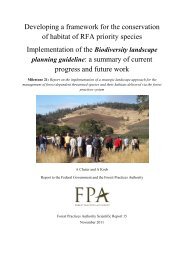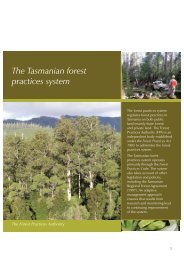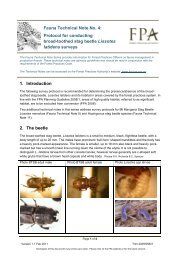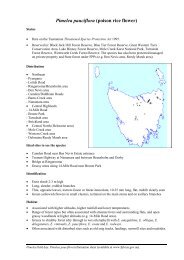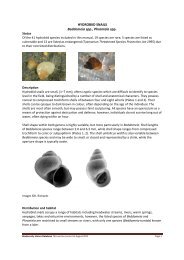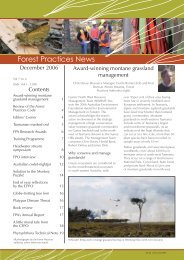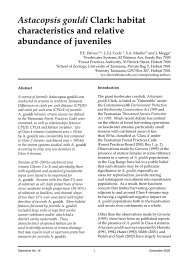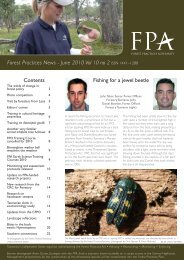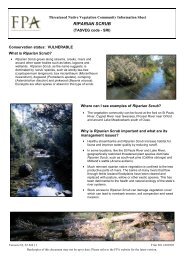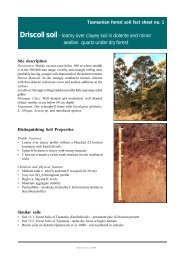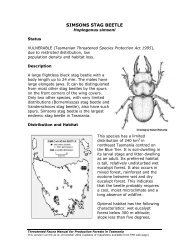Nest identification - The Forest Practices Authority
Nest identification - The Forest Practices Authority
Nest identification - The Forest Practices Authority
You also want an ePaper? Increase the reach of your titles
YUMPU automatically turns print PDFs into web optimized ePapers that Google loves.
Fauna Technical Note No. 14:<strong>Nest</strong> Identification<strong>The</strong> Fauna Technical Note Series provides information for <strong>Forest</strong> <strong>Practices</strong> Officers on fauna management inproduction forests. <strong>The</strong>se technical notes are advisory guidelines and should be read in conjunction with therequirements of the <strong>Forest</strong> <strong>Practices</strong> Code.<strong>The</strong> Technical Notes can be accessed on the <strong>Forest</strong> <strong>Practices</strong> <strong>Authority</strong>’s website: www.fpa.tas.gov.au1. How did you know that wasn't an eagle nest?Identification of eagle and goshawk nests can be tricky, even for the specialists. In answer to thiscommon question we have put together these notes on things to look for when trying to decide towhom that large collection of twigs you have just found belongs? However, if in doubt ask for a sitevisit by a specialist.In Tasmania, there are only four raptor species which build large nests in trees; the wedge-tailedeagle, white-bellied sea eagle, grey goshawk and brown goshawk. Other birds that build such nestsare the forest raven, two species of currawong and the white-faced heron. <strong>The</strong> brown falcon andAustralian hobby do not build their own nests but use the disused goshawk or raven nests.Some tips for nest <strong>identification</strong>Twig size is very helpful when identifying nest type. When viewing a nest through binoculars, a helpfultool for assessing twig size is to use leaves occurring close to the nest as a ruler: first identify the typeof leaves that occur close to the nest and determine the typical length of these leaves, then use theseto visually ‘measure’ some of the twigs in the nest when viewing through the binoculars.Accurate <strong>identification</strong> of pellets is a great aid to nest <strong>identification</strong>. A tool to aid with pellet<strong>identification</strong> is currently in preparation. For assistance with <strong>identification</strong> in the interim, photos orsamples of pellets can be sent to FPA Biodiversity Program staff.2. Wedge-tailed eagle and white-bellied sea eagleA very large nest, when in use, is usually about 1.2 m across and 1 m deep (range from 3 m acrossand 3 m deep to 0.8 m across and 0.5 m deep) and is built in large, live eucalypts at the canopy level.Sea eagles are more flexible in their preferences, often using dead eucalypts and sometimes usingtea tree, she-oaks, pines and rock stacks (on islands).<strong>The</strong> nest is usually situated snugly against the main trunk on the downhill side of a tree where two ormore large limbs protrude, giving very strong support and the least amount of wind movement. <strong>Nest</strong>material comprises sticks from pencil sized up to 40 mm in diameter. Most sticks are about thethickness of one's little finger. <strong>The</strong> nest has a nest bowl lined with bark and leaves. Sea eagles oftenuse sea weed.It is rare that any part of a sitting bird can be seen from under the nest. Whitewash under nests withadvanced chicks can be extensive. Pellets and other prey remains mainly represent mammals butthere may be remains of birds, reptiles and fish scattered about. <strong>The</strong>se two species often compete fornest sites so care has to be taken in deciding what species is actually in residence.CautionAn unusually small or degraded eagle nest can be difficult to identify. However, such nests will stillhave large sticks in the base and be on limbs that seem too large for the nest. Such small or degradedPage 1 of 3Version 2.2 Trim 2009/35444Hardcopies of this document may not be up to date. Please refer to the FPA website or for the latest version.
Fauna Technical Note No. 14 <strong>Nest</strong> Identificationnests often are lost in a deep fork. A small nest may seem larger than it is if bark and other detritushave collected on top. Look for the structural material; bark is not usually utilised by eagles as anesting material.3. Grey goshawkGrey goshawks most frequently nest in blackwood, silver wattle, myrtle or sassafrass. In some (rare)cases they may nest on an epiphyte growing on any of the above (where their nest may barely bevisible). <strong>The</strong>se trees may be associated with a swamp forest or a narrow strip growing along a smallcreek amongst eucalypts. <strong>The</strong> nest of the grey goshawk tends to be situated beneath the shady crownof a tree, close to bases of limbs which provides a more sturdy foundation with less likelihood of thenest structure flexing in winds. If in large trees (such as eucalypts) the nests are more likely to be outon a limb built into a multi-forked structure. <strong>The</strong> nest is usually about 50 cm across and made of sticksup to 20 mm thick. <strong>The</strong> tail tip of a sitting grey goshawk may at times be visible protruding from thenest.Whitewash under nests with advanced chicks can be obvious but may not be visible immediately aftera heavy rainfall event. Pellets mainly contain remains of birds and small mammals and there may befurther remains of their prey scattered about.4. Brown goshawkGrey goshawk and brown goshawk habitat preferences do overlap so nest <strong>identification</strong> may bedifficult. <strong>The</strong> nest and sticks used by brown goshawks and grey goshawks are very similar in size andstructure. However, brown goshawk nests tend to be on a junction of several limbs out from the mainstem of tree, particularly where epicormic growth come up from the branch. Brown goshawks show amarked preference for eucalypts and do not nest in isolated trees or in wet forest types. BrownGoshawk nests are usually in the lower canopy of the tree and they usually choose much larger treesthan grey goshawks. <strong>The</strong> tail tip of a sitting brown goshawk may be visible protruding from the nest.Whitewash under nests with advanced chicks can be extensive. Pellets mainly contain remains ofbirds, reptiles and small mammals. <strong>The</strong>re may also be remains of these prey scattered about.5. <strong>Forest</strong> ravens and currawongs<strong>Nest</strong>s of these birds are most often placed in the upper canopy amongst the extremities of outer limbs.In this situation, the nests would sway around a lot in wind and therefore would not be suitable forgoshawks (ravens and currawongs are better able to manipulate twigs and they use a wide range ofmaterials to bind their nest together). <strong>The</strong> raven’s or currawong’s nest is typically built of sticks lighterthan those of goshawks and in rural areas often includes bale twine, plastic bale wrap and other farmdebris. Usually it is about 60cm in diameter and 25–30 cm deep. Raven nests are often in isolated,even dead trees. Raven nests are often not deep structures and the incubating bird can sometimesclearly be seen on the nest.Whitewash under nests with advanced chicks can be extensive. Pellets can contain all manner of preybut typically are dominated by ground dwelling invertebrates, berries and undigested grain. Faeces oflarge animals may also be present in pellets, as these birds may look for invertebrates in animal dung.Brown goshawks, grey goshawks, brown falcons and forest ravens may compete for nest sites so carehas to be taken in deciding what species is actually in residence.6. White-faced heronThis heron's nest is typically a shallow platform of sticks, up to 1 m in diameter and less than 200 mmdeep. <strong>The</strong> nest tends to be very scraggly and untidy looking. Sticks are often not well arrangedcompared to a goshawk nest and may be in any species of large tree. <strong>The</strong> heron nest is often very flatPage 2 of 3Version 2.2 Trim 2009/35444Hardcopies of this document may not be up to date. Please refer to the FPA website or for the latest version.
Fauna Technical Note No. 14 <strong>Nest</strong> Identificationand open and located within easy reach, half a km or less, of foraging habitat i.e. large river, openfarm land, marshes etc. Herons may nest in exposed trees.Large splashes of whitewash are usually under active heron nests and pellets often containcrustacean remains.Publication detailsThis technical note has been prepared by Simon Plowright (Wildspot Tours), Nick Mooney (formerly ofDPIPWE) and FPA Biodiversity Program staff. It should be cited as:<strong>Forest</strong> <strong>Practices</strong> <strong>Authority</strong> 2010, ‘<strong>Nest</strong> <strong>identification</strong>’, Fauna Technical Note No. 14, <strong>Forest</strong> <strong>Practices</strong><strong>Authority</strong>, Hobart.Contact details<strong>Forest</strong> <strong>Practices</strong> <strong>Authority</strong>: 30 Patrick Street, Hobart, Tasmania 7000.Phone: (03) 6233 7966Fax: (03) 6233 7954; Email: info@fpa.tas.gov.au; Website: www.fpa.tas.gov.auDocument Summary InformationDocument nameFauna Technical Note No.14: <strong>Nest</strong> IdentificationVersion 2.2Trim record 2009/35444OwnerAuthor(s)Biodiversity Section StaffBiodiversity Section StaffRelease date February 2010Release Approved byRelease statusBiodiversity ManagerPublic documentVersion ControlVersion Date Author(s) Summary of changes2 Feb 2010 BiodiversitySection StaffDocument previously available on FPA website revised. Previousrevisions pre-date document control.2.1 Feb 2011 Nina Roberts Note: the wording of this document is identical to that approvedby the FPA Biodiversity Manager in early 2010, except for theaddition of document control information.2.2 Oct 2014 Amy Koch Minor edit_ remove reference to pellet technical notePage 3 of 3Version 2.2 Trim 2009/35444Hardcopies of this document may not be up to date. Please refer to the FPA website or for the latest version.



